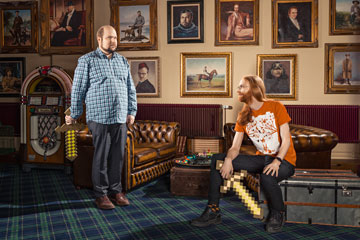
Persson, far left, and Bergensten, the minds behind Minecraft, brandishing the game's pixelated swords
(4 of 6)
The long-term vision that Notch and Jeb share for Minecraft consists in part of not obsessing over long-term vision. Mojang releases a few updates with new features each year; at the time I visited the company in Stockholm, it had just shipped version 1.5. "When it came out, we were already working on 1.6," Jeb says. "That's very unusual that we knew what was coming. For 1.7, we have a couple of options. But what it looks like in a year, I have no idea."
Judging from Minecraft's history, it's the game's players, at least as much as its creators, who will determine its future. They'll continue to design new worlds and useful mods, share their work on YouTube and generally provide most of the incentive for fellow players to spend time with the game. For Mojang, getting in the way of the players would be more dangerous than making sure they have free rein to build, build, build.
A lot of those builders are kids. Minecraft attracts enormous numbers of teens, preteens and nowhere-near-teens; children as young as 3 are entranced by it. Notch says he didn't plan it that way and isn't positive why kids like Minecraft so much: "I might be a little childish," he muses. "Or maybe children have really good taste in games." Even if it was an accident, Minecraft is a game that both kids and their parents can love. While there's combat and conflict, it has nothing resembling the graphic ghoulishness of 2012's best-selling game, Activision's Call of Duty: Black Ops II, which features severed limbs, exploding heads, gushing blood and rotting bodies, all rendered in as much detail as possible. "I'm grateful that Notch said from the beginning that he didn't want gore," says Jeb. "There's violence, but it's cartoonish."
Kids become fans for different reasons. "For me, it's like, you can do anything," says 12-year-old Noah Sokolsky of Fanwood, N.J. "There's always a surprise--every block you break, every block you build, every step you take. It's exciting." Among the things Noah has constructed in Minecraft: a lighthouse, a waterfall that splits in half to reveal a hidden door and a machine that spits out cobblestones. Noah's 9-year-old brother Joshua is a fan too, but for more primal reasons: "You get to have all these weapons and fight monsters. I rarely build." Eric, their father, has a guardedly positive attitude toward the game, though he does worry about its tendency to become a 24/7 fixation. (He admits to once secretly unplugging the household's Internet router to foil plans by Noah and a sleepover buddy to begin playing Minecraft at 3 a.m.)
The luckiest young players get to spend time in Minecraft at school as well at home. MinecraftEdu, a partnership of Minecraft enthusiasts in Finland, Spain and New York City, helps teachers use the game as a virtual classroom for everything from geography to math to art; the company has sold its education-ready version of the game to about 1,200 schools to date. "We have been looking at 10% to 20% growth per month in schools that are using it," says co-founder and CEO Santeri Koivisto. "We don't see any end to this." As with other aspects of the ever-expanding Minecraft community, the game's creators are supportive of its uses in education but happy to let someone else take the lead.
